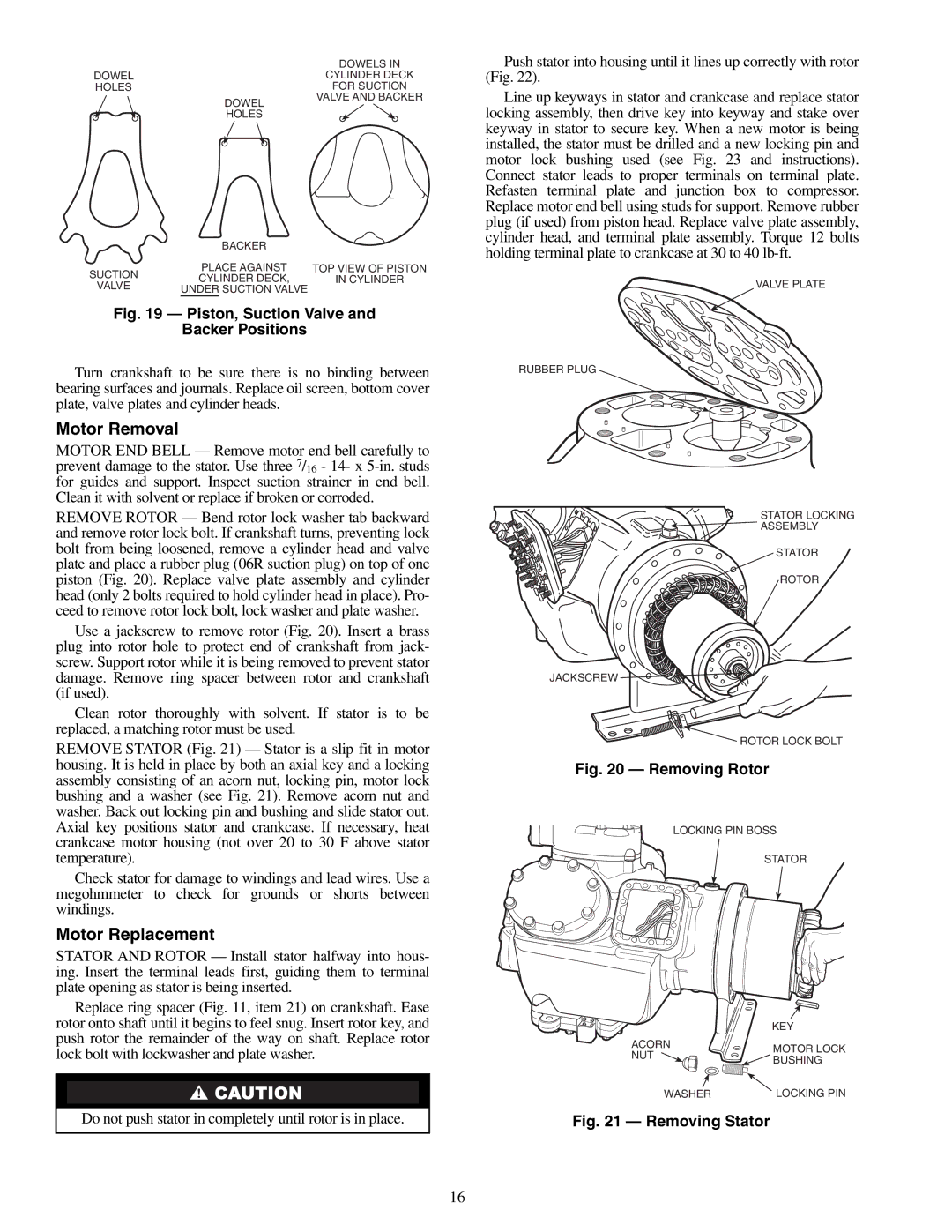
|
| DOWELS IN |
DOWEL |
| CYLINDER DECK |
HOLES |
| FOR SUCTION |
| DOWEL | VALVE AND BACKER |
|
| |
| HOLES |
|
| BACKER |
| |
SUCTION | PLACE AGAINST | TOP VIEW OF PISTON | |
CYLINDER DECK, | IN CYLINDER | ||
VALVE | |||
UNDER SUCTION VALVE |
| ||
|
|
Fig. 19 — Piston, Suction Valve and
Backer Positions
Turn crankshaft to be sure there is no binding between bearing surfaces and journals. Replace oil screen, bottom cover plate, valve plates and cylinder heads.
Motor Removal
MOTOR END BELL — Remove motor end bell carefully to prevent damage to the stator. Use three 7/16 - 14- x
REMOVE ROTOR — Bend rotor lock washer tab backward and remove rotor lock bolt. If crankshaft turns, preventing lock bolt from being loosened, remove a cylinder head and valve plate and place a rubber plug (06R suction plug) on top of one piston (Fig. 20). Replace valve plate assembly and cylinder head (only 2 bolts required to hold cylinder head in place). Pro- ceed to remove rotor lock bolt, lock washer and plate washer.
Use a jackscrew to remove rotor (Fig. 20). Insert a brass plug into rotor hole to protect end of crankshaft from jack- screw. Support rotor while it is being removed to prevent stator damage. Remove ring spacer between rotor and crankshaft (if used).
Clean rotor thoroughly with solvent. If stator is to be replaced, a matching rotor must be used.
REMOVE STATOR (Fig. 21) — Stator is a slip fit in motor housing. It is held in place by both an axial key and a locking assembly consisting of an acorn nut, locking pin, motor lock bushing and a washer (see Fig. 21). Remove acorn nut and washer. Back out locking pin and bushing and slide stator out. Axial key positions stator and crankcase. If necessary, heat crankcase motor housing (not over 20 to 30 F above stator temperature).
Check stator for damage to windings and lead wires. Use a megohmmeter to check for grounds or shorts between windings.
Motor Replacement
STATOR AND ROTOR — Install stator halfway into hous- ing. Insert the terminal leads first, guiding them to terminal plate opening as stator is being inserted.
Replace ring spacer (Fig. 11, item 21) on crankshaft. Ease rotor onto shaft until it begins to feel snug. Insert rotor key, and push rotor the remainder of the way on shaft. Replace rotor lock bolt with lockwasher and plate washer.
Do not push stator in completely until rotor is in place.
Push stator into housing until it lines up correctly with rotor (Fig. 22).
Line up keyways in stator and crankcase and replace stator locking assembly, then drive key into keyway and stake over keyway in stator to secure key. When a new motor is being installed, the stator must be drilled and a new locking pin and motor lock bushing used (see Fig. 23 and instructions). Connect stator leads to proper terminals on terminal plate. Refasten terminal plate and junction box to compressor. Replace motor end bell using studs for support. Remove rubber plug (if used) from piston head. Replace valve plate assembly, cylinder head, and terminal plate assembly. Torque 12 bolts holding terminal plate to crankcase at 30 to 40
VALVE PLATE
RUBBER PLUG
STATOR LOCKING
![]() ASSEMBLY
ASSEMBLY
STATOR
ROTOR
JACKSCREW ![]()
![]() ROTOR LOCK BOLT
ROTOR LOCK BOLT
Fig. 20 — Removing Rotor
LOCKING PIN BOSS
STATOR
| KEY | |
ACORN | MOTOR LOCK | |
NUT | ||
BUSHING | ||
| ||
WASHER | LOCKING PIN |
Fig. 21 — Removing Stator
16
